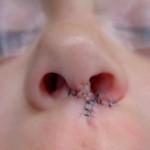Reshaping the nose in the cleft patient represents one of the more challenging of all rhinoplasty surgeries. Efforts are made a various time periods from the initial cleft lip repair to teenage years to make nose corrections. But the tissue deformities inherent in the cleft nose almost always defies a completely satisfying result.
Of the many well known anatomic problems in the cleft nose, a columellar skin deficiency is one of them. This is most manifest in the bilateral cleft patient but exists to a lesser degree in the unilateral cleft as well. This lack of columellar skin length can mar an otherwise good realignment and reshaping of the tip cartilages at the completion of an open rhinoplasty. As when the skin is closed over the reshaped tip, the lack of columellar skin will pull down on the uplifted side of the dome causing a distortion of the nostril height and shape on the cleft side.
Different surgical strategies have been used to address this issue including columellar lengthening through V-Y lengthening closure methods. But they are not always successful in more severe unilateral cleft noses.

Dr. Barry Eppley
Indianapolis, Indiana



